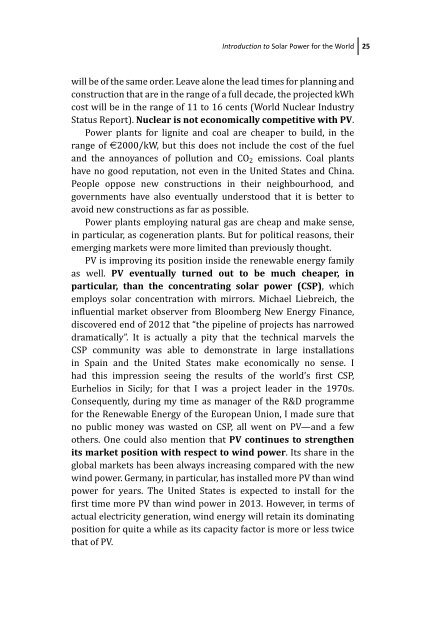Download PDF - Pan Stanford Publishing
Download PDF - Pan Stanford Publishing
Download PDF - Pan Stanford Publishing
Create successful ePaper yourself
Turn your PDF publications into a flip-book with our unique Google optimized e-Paper software.
Introduction to SolarPowerfortheWorld 25<br />
will be of the same order. Leave alone the lead times for planning and<br />
construction that are in the range of a full decade, the projected kWh<br />
cost will be in the range of 11 to 16 cents (World Nuclear Industry<br />
Status Report). Nuclear is not economically competitive with PV.<br />
Power plants for lignite and coal are cheaper to build, in the<br />
range of e2000/kW, but this does not include the cost of the fuel<br />
and the annoyances of pollution and CO 2 emissions. Coal plants<br />
have no good reputation, not even in the United States and China.<br />
People oppose new constructions in their neighbourhood, and<br />
governments have also eventually understood that it is better to<br />
avoid new constructions as far as possible.<br />
Power plants employing natural gas are cheap and make sense,<br />
in particular, as cogeneration plants. But for political reasons, their<br />
emerging markets were more limited than previously thought.<br />
PV is improving its position inside the renewable energy family<br />
as well. PV eventually turned out to be much cheaper, in<br />
particular, than the concentrating solar power (CSP), which<br />
employs solar concentration with mirrors. Michael Liebreich, the<br />
influential market observer from Bloomberg New Energy Finance,<br />
discovered end of 2012 that “the pipeline of projects has narrowed<br />
dramatically”. It is actually a pity that the technical marvels the<br />
CSP community was able to demonstrate in large installations<br />
in Spain and the United States make economically no sense. I<br />
had this impression seeing the results of the world’s first CSP,<br />
Eurhelios in Sicily; for that I was a project leader in the 1970s.<br />
Consequently, during my time as manager of the R&D programme<br />
for the Renewable Energy of the European Union, I made sure that<br />
no public money was wasted on CSP, all went on PV—and a few<br />
others. One could also mention that PV continues to strengthen<br />
its market position with respect to wind power. Its share in the<br />
global markets has been always increasing compared with the new<br />
wind power. Germany, in particular, has installed more PV than wind<br />
power for years. The United States is expected to install for the<br />
first time more PV than wind power in 2013. However, in terms of<br />
actual electricity generation, wind energy will retain its dominating<br />
position for quite a while as its capacity factor is more or less twice<br />
that of PV.
















